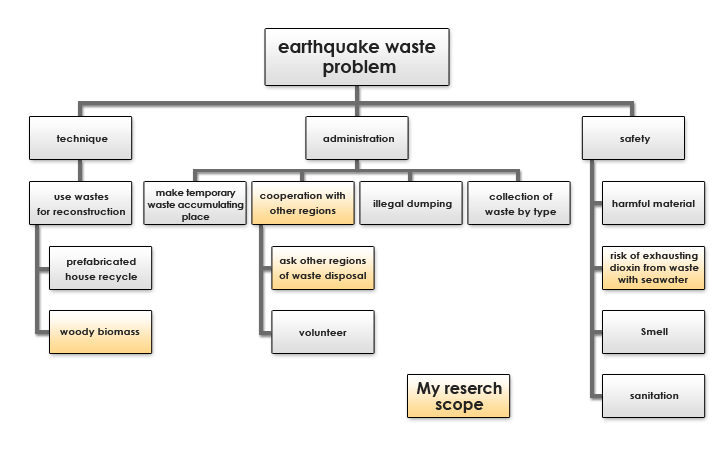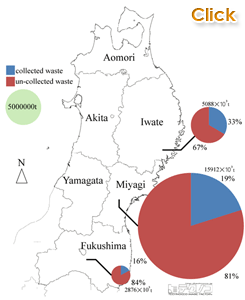Waste problems caused by the East Japan Great Earthquake
Shotaro Nakanishi
1. Introduction
In the recent East Japan great earthquake, wastes generated due to the Tsunami are a very crucial problem the government is now facing. The amount of wastes at Pacific Ocean side Tohoku's 3 prefectures (Iwate, Miyagi, and Fukushima) is several times larger than the amount of wastes that the area usually generating in a year. There are many problems because of the tremendous amount and special condition that most of the wastes were immersed in seawater because of Tsunami. Figure 1 is the amount of earthquake wastes and ratio of collected and uncollected ones. Ministry of the Environment estimated the amount of wastes at coastal area, using satellite pictures (Figure 1).
Miyagi's wastes are about five times larger than Fukushima and three times larger than Iwate's. It may be because Sendai city the center of the Miyagi prefectural government- is the hub of all Tohoku region, and population centre. Fukushima has collected only 16% of waste because the nuclear power plant's accident delayed the work.
Table.1 is the comparison of the amount of earthquake waste with the annual waste production in the region.
| Prefecture | normal time waste amount [1000t/year] | earthquake waste amount [1000t] | *1 [year] |
|---|---|---|---|
| Fukushima | 809 | 2876 | 3 |
| Miyagi | 793 | 15912 | 20 |
| Iwate | 451 | 5088 | 11 |
*1Years needed to treat the wastes by normal capacity of waste treatment.
_*1[year]=(amount of waste generated by earthquake)/(annual waste amount)
Very large amount of waste which has been generated in several years were generated in a moment. Of course incinerators can treat more wastes than usually they treated. But that is not enough (Table.2).
| Prefecture | Number of incinerators | Incinerators capacity [t/day] |
|---|---|---|
| Fukushima | 25 | 2931 |
| Miyagi | 19 | 3438 |
| Iwate | 21 | 2256 |
Full time running of incinerators cannot treat earthquake waste in a few years either. Tohoku region needs to be reconstructed as soon as possible. How to treat the wastes quickly is the key point of the reconstruction.
2. Framework of the Problem
Besides the amount of the waste, there are many problems about earthquake waste. Here I summarize a framework of earthquake waste problems (Figure.2).

Figure.2 Framework of earthquake waste problems
First I classify the problems into three groups; technical problems, administrative issues and safety issues. Technical problems are the category about use of wastes and its treating for reconstruction. For example, professor Sekino Noboru at Iwate University now runs a project to produce veneer boards using wood wastes and use them for prefabricated community centers.
The second category is administration. Local governments have to decide where to temporarily collect large amount of wastes, how to collect and treat wastes by type, and how to suppress illegal dumping. Local and national government have asked other regions help. Other regions can send supplies and volunteer, and can accept disaster wastes.
The third category is safety. It is about the human health. Earthquake wastes are very complex and some materials like asbestos can harm waste collecting workers. After collecting them, how to keep them and treat them are another problems. Because keeping wastes without any treatment for a long time, the smell of wastes becomes trouble in many places. It becomes another sanitation problem.
My research focused two points; cooperation of other regions and wood wastes.
Cooperation of other regions: To treat the large amount of waste, other regions in Japan need to help treating wastes, but moving waste to other regions have not started yet, because some citizens' claim the danger of radioactivity from the wastes at Tohoku. This is the critical problem.
Wood waste: Japanese houses are usually made of wood. Houses damaged by the Tsunami became large amount of wood waste. The wood wastes with seawater have risk of exhausting dioxin when combusted. So the wood wastes now become one of the problems the local government is facing. However they are possibly to be reused or recycled and contribute to the reconstruction.
3. Cooperation of other regions
The Miyagi prefecture and the Ministry of the Environment plan to carry all wastes out of city area to temporary collecting places within a year and finish waste treatment within three years (9),(10).Table1& 2 show that Tohoku cannot treat the earthquake wastes within a few years on their own. So other area's incinerators are needed to reconstruct Tohoku as soon as possible.
Other regions' governments help Tohoku by another way, like sending experts, trucks and special cars. However moving wastes operations have not started yet. There are citizen's criticisms for moving earthquake wastes because the wastes may cause pollution due to its radioactivity. Some Internet comment says that “Do not spread the radioactive pollution to all Japan.”(11) At Kyoto, the city government announced that it can treat 50000t wastes from Tohoku per a year. A parents group ran signature-collecting campaign that request Kyoto city government not to accept wastes from Tohoku. (12).
I think the citizen's apprehensions are very natural, but their insistences are just sentimental argument. It is necessary that city government, citizen and expert discuss the risk of radioactivity and merit of Tohoku's reconstruction.
4. Salty wood waste : problem of salt removal (13)
In the recent East Japan great earthquake, wastes generated due to the Tsunami are a very crucial problem the government is now facing. There are especially large amount of wood waste with seawater.
Basically, rainfall will remove the salt accumulated in the wood wastes. Then wastes will be burned in the incinerator with a controlled high temperature and an exhaust gas treatment.
4-1. Basic information
- With the possible additional problem of producing dioxin when wood waste will be directly treated, it is therefore better to remove accumulated salt and dirt firsts and then burn them in the incinerator with a controlled temperature of about 800℃+ and an exhaust gas treatment.
- It is not yet proven whether salty wood incineration produces dioxin. A report says, however, that the dioxin concentration from a city incinerator became twice larger after a typhoon passed the city. Another study showed that removing of salt and high temperature burning can reduce the dioxin exhaustion. Therefore, we need to remove as much salt as possible from wood wastes.
- Some of the salty wood wastes can be recycle after removing salt.
4-2. Disposal site
- The salt from the wood wastes need to be removed by rainfall (or river water, farm water-, running water- if possible).
- Almost all of the wood wastes' salt were accumulated within a centimeter of the cortex. About 80cm cumulative rainfall can remove almost 97-99% of salt. So, salt in the tsunami wastes is predicted to be completely removed after the rainy season.
- We need to keep wastes from spontaneous combustion. If the waste piled up in the open, the piles must be kept lower than 5m, narrower than 200m².Distance between piles must be wider than 2m.
- Less and less salt, warmer and warmer, the risk of going moldy or growing mushroom will rise. It is necessary to spread calcium hydroxide or burn woody wastes soon after removing salt.
4-3.Caution
Advance checks and considerations are needed because some wood wastes can be with bottom sediment or be treated with CCA (copper, chromium and arsenic). Burning some kind of sediment and CCA will damage the environment.
5. Recommendations
At Tohoku, collecting and treating wastes have been done. There are several problems like Fukushima`s nuclear polluted wastes and salty waste. The tremendous wastes' amount is one of these problems. I perceive that is the bottleneck to reconstruct Tohoku. To solve this bottleneck, I think moving the wastes to other regions are needed. I also think citizens worry is natural. Discussions between citizens, local governments and experts about risk and quick conclusion are important for Tohoku's speedy reconstruction.
References
-
(1) Coastal area`s progress of treating wastes
「沿岸市町村の災害廃棄物処理の進捗状況」
http://www.cao.go.jp/shien/3-info/3-ugoki/110610shiryo-1.pdf#page=1 -
(2) White map from Technocco white map illustration
テクノコ白地図イラスト
http://technocco.jp/n_map/n_map.html -
(3) Fukushima waste treating plan
福島県廃棄物処理計画
http://wwwcms.pref.fukushima.jp/download/1/itupan-waste-man.-plan.pdf -
(4) Report of waste generating and treating at Miyagi
宮城県における一般廃棄物の排出及び処理状況等について
http://www.pref.miyagi.jp/sigen/ippan/ippan_index.htm -
(5) The amount of waste at Iwate,2009
岩手県:平成21年度、451千トン県内市町村のごみ排出量(速報値)について
http://www.pref.iwate.jp/view.rbz?nd=2649&of=1&ik=1&pnp=50&pnp=2648&pnp=2649&cd=28371 -
(6) Incinerator at Miyagi report
宮城県 一般廃棄物処理施設の設置状況
http://www.pref.miyagi.jp/sigen/junkankeikaku/kakutei/pdf/06shiryo2-2.pdf -
(7) Summary of waste treating at Iwate, 2009
岩手県 平成21年度一般廃棄物処理事業の概要
http://www.pref.iwate.jp/download.rbz?cmd=50&cd=31181&tg=4 -
(8) Report of Japan waste, 2005
一般廃棄物の排出及び処理状況等(平成17年度実績)について
http://www.env.go.jp/press/press.php?serial=8277 -
(9) Congress for earthquake waste at Miyagi
第1回宮城県災害廃棄物処理対策協議会資料より
http://www.pref.miyagi.jp/haitai/kyougikai/pdf/01/02_miyagi.pdf -
(10) Master plan for East Japan great earthquake waste, the Ministry of Environment
環境省:東日本大震災に係る災害廃棄物の処理指針(マスタープラン)平成23年5月16日
http://www.env.go.jp/jishin/attach/haiki_masterplan.pdf -
(11)The problem of moving radioactive wastes wiki
原発震災廃棄物・広域処理問題@まとめ
http://www47.atwiki.jp/tsunamiwaste/pages/1.html -
(12) Kyoto Parents' Association to Protect Children from Nuclear Radiation
http://kodomo-kyoto.sakura.ne.jp/ -
(13)Manual of disaster wastes
「災害廃棄物分別・処理戦略マニュアル ~東日本大震災において~」p38,39 災害廃棄物対策・復興タスクチーム
http://eprc.kyoto-u.ac.jp/saigai/report/manual/index.html




